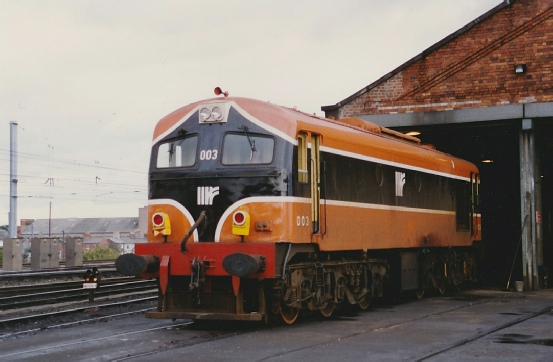Archive Section
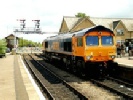

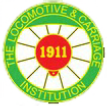

6th -
Text by John Lunn, General Secretary,
Photos © Tom Chaffin
CLICK IMAGES FOR AN ENLARGEMENT
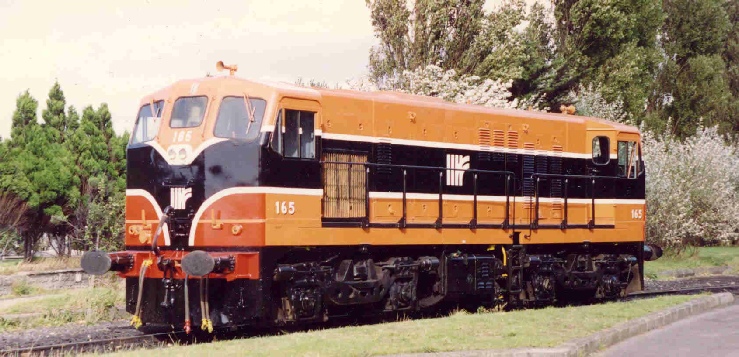
IE 161 Class No 165 Stands outside Inchicore Works 7th September 1992
Sunday 6th September:
The main body of the party met at Euston Station at around 09.00, most of us indulging in a cup of coffee before departing on the 09.20 for Holyhead. This train is now formed from a Plymouth based H.S.T. set and sees the return of regular diesel working into Euston for the first time since 1966. Four more members joined at Watford Junction and one more at Chester, this brought the total party up to 20, being three wives and 17 members. The journey to Holyhead was uneventful apart from passing a steam hauled excursion at Llandudno Jct. headed by Princess Royal class 4-
Monday 7th September:
Monday morning got off to a bumpy start, our instruction to be at Connolly station at 09.00 to meet Tom Devoy was obeyed to the letter, however as 09.20 approached I decided to find out why Mr Devoy had not appeared. Enquiring at the Station Master's office, I was told to try the head office building. Myself and the vice chairman David Kirkland made our way to the main office where moves were made to sort out our problems. We were asked to take a seat and for nearly 20 minutes
Mr Kirkland and I, observed the traffic passing our seat, most of it carried bits of paper -
Dermot Gaffney, the yard manager and a dedicated railwayman. The tour of the yard started by walking through the sundries stores which is used for breaking down bulk loads for local distribution. From here we moved on to see a freightliner being loaded by a container carrying fork lift, quite a large and impressive vehicle. The train being loaded was the 11.35 to Belfast and was loaded with containers for forwarding to Liverpool and B.R. All container traffic between Ireland and the UK now travels this way since Sealink refused to handle containers at Holyhead. North Wall handles about 14 -
A couple of pleasant hours were spent looking at this pleasant coastal town. Cobh had been an alighting point for the Cunard and White Star liners en route to the new world as well as a port for freighters and fishing ships. Dominating the town is the magnificent cathedral built at around the turn of the century.
Before returning to Cork on the 13.45, three of us tried some Cork stout in what turned out to be Cobh's oldest pub. This was a splendid small-
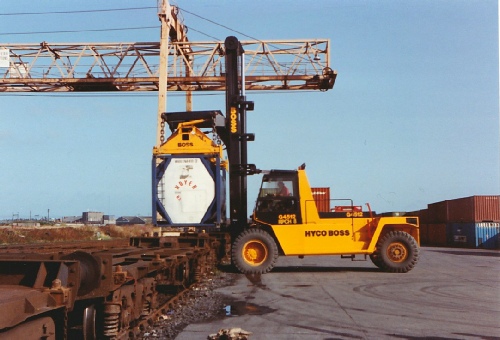
Container transfer between rail and road at Dublin North Wall Goods Yard
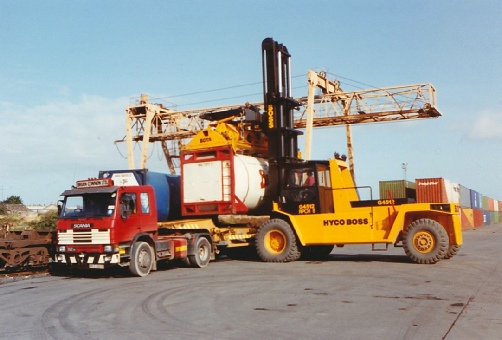
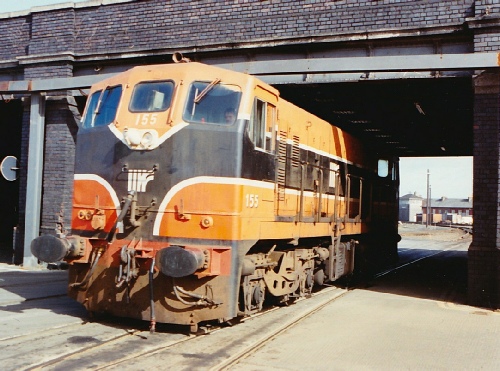
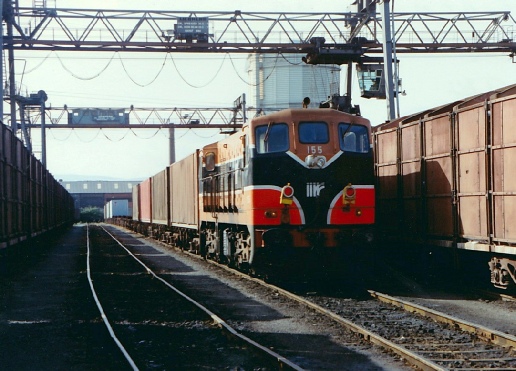
Small GM 141 Class No. 155, arrives at North Wall Yard and gets ready for departure with the 11.35 to Belfast 07/09/1992
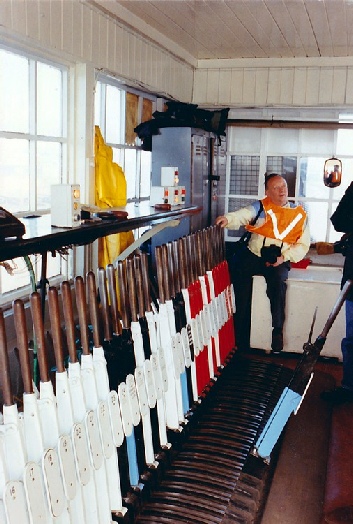
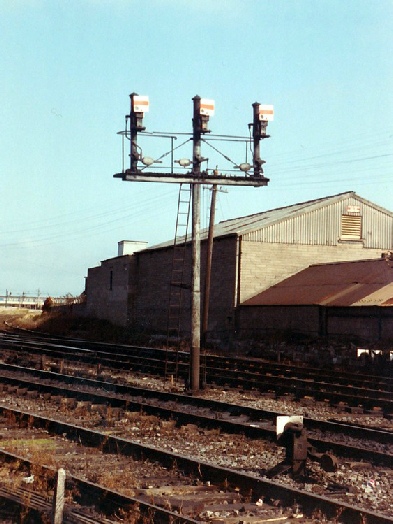
After visiting the Church Road box which controls the movements into and out of the yard, we returned to the yard offices where the Watford lot made a presentation to Mr Gaffney, this being accompanied by photos being taken for the Watford area News.
Inside Church Road Signal Box at North Wall Yard, Left and shunt signals on a gantry, right
After bidding our farewells, we returned to the board room in Connolly where tea and coffee was waiting. At this juncture, Tom Devoy who is the District operating manager Northern had to take his leave, but before he departed he introduced us to our next hosts and I took the opportunity to present him with a tie.
Regrettably I failed to record the names of our next hosts, these gentlemen being the C.T.C. (Central Traffic Control) manager and technical manager, and they would conduct us around the C.T.C.. After coffee we walked across to the C.T.C. building; like similar installations in the UK high steel fencing surrounds the building and entry is through an electronically locked gate. We went first to the main line panels, these control the main line movements but not the D.A.R.T. line. Mainlines under control of Dublin now extend to Cork, Bray, Athlone and Athy. All the track diagrams are on colour closed circuit TV screens. Whilst the signalling practice is the same as that used on B.R., all the equipment is supplied by Union Switch and Signal of New York USA. The panel itself is operated by two men, one acting as signalman and the other as operator. Compared with when we saw this panel first in 1987, this is now a much expanded operation and one that keeps two men very busy. So much time was spent looking at this panel that only a short period could be spent on the D.A.R.T. panels. A quick explanation of the operation of the panels controlling the D.A.R.T. was given and it was explained that the four signalmen operating both signal and level crossing panels (two on each) changed places every two hours. A brief look was made into the room which housed the emergency panel controlling Connolly station, this being in use at the time because of engineering work.
We now had to depart for lunch in Connolly station, being a bit behind time at this point set the stage for the afternoon. Lunch was a splendid affair and was attended briefly by Mr David Waters, the General Manager of Irish Rail who bid us welcome to Ireland and Irish Rail. The opportunity was also taken to present Mr Waters with an Institution meeting folder.
We departed for Inchicore works at 14.45, 45 minutes late. Because of the late running we caught a bus to Heuston station then completed the journey by taxi. On arrival we were asked to sign an indemnity at the reception desk before the party was split into three groups for the tour around Inchicore works. We should have been accompanied on this tour by the Chief Mechanical Engineer, Dick Grainer, but unfortunately Mr Grainer was detained at a meeting.
Our guides set off with each group in different directions. The group that I was with went first to the machine shop in which many small parts for a multiplicity of uses are machined and from here we went into the wagon shop which it was noted had recently been re-
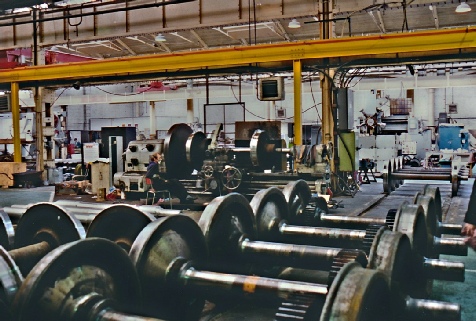
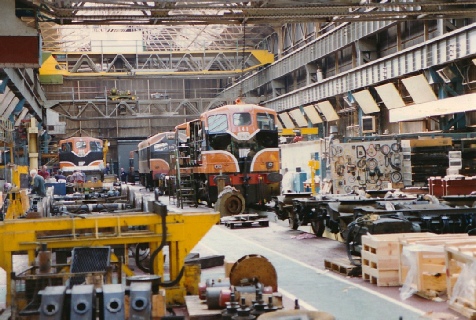
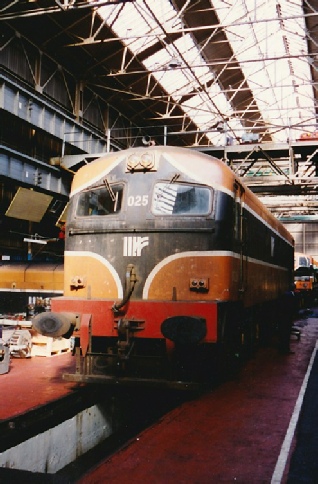
Small GM 141 Class No. 141,
Large GM 071 Class No. 084 and
A001 Class No. 016 under repair
Wheelsets receiving attention.
Note the lithe in the middle centre of the picture.
Metro Vic A001 Class No. 025 in Inshicore works.
These locomotives were manufactured by Metropolitan-
Due to poor reliability of this engine, they were reengined with 12-
All have now been withdrawn though 003, 015, 039 and 055 have been preserved.
We then passed through the present carriage shop in which Craven coaches and generator vehicles were receiving attention. We then walked via the locomotive running shed to where a various collection of withdrawn locomotives had accumulated and also where wholesale scrapping had started on the A & C class locomotives that used to form the Inchicore Barrier. Amongst these locos was Nos. 103 113 and 114 of the B class, all of which are earmarked for preservation. Alongside the line of locomotives being broken up was a row of sheeted G.M. engines from scrapped locos -
Following this look at the scrap yard we went next to the locomotive repair shop in which we noted four locomotives in various states of repair.
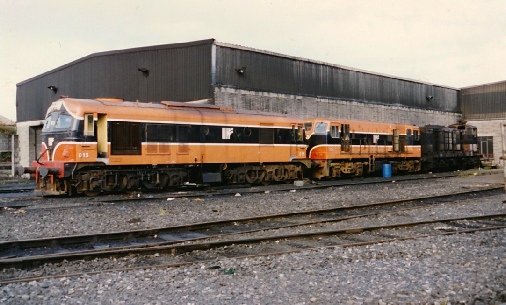
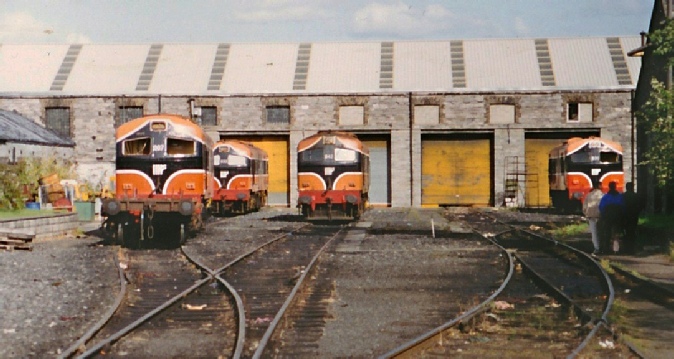
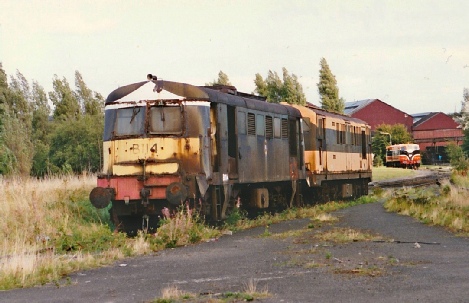
A001 Class No. 015 and Small GM 141 Class No. 158, plus unidentified 121 Class at the rear.
Front: B113 Class No. 114. Only two of the class of locos were built , construction being by CIÉ at Inchicore Works This engine was eventually scrapped In March 1995.
Rear: B101 Class No. 103. One of 12 locomotive built by Birmingham Railway Carriage and Wagon Company. This engine is now preserved by the Irish Traction Group at Carrick-
A001 Class members from left to right No. 007, 033, 042 and 031 outside Inshicore works
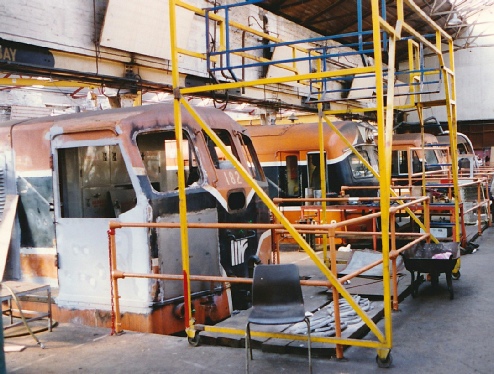
Small GM 181 Class No. 182 receives attention including replating of part of the cab, A001 Class No. 038 behind.
The 181 Class were built in 1966 by General Motors Electro-
After this we returned to the apprentice training building for tea and biscuits and a talk with our guides. Two of the three groups returned almost together but despite a wait of 30 minutes or more the third group did not return so we made our way back to Dublin and an early drink to lay the dust. It was whilst having this drink that the members of the third group turned up and it transpired that they had had a very interesting and detailed visit which must have been quite something as we had all had a very interesting afternoon.
Tuesday 8th September:
Our instruction for Tuesday morning was to catch a No. 30 bus from Lower Abbey St to the D.A.R.T. maintenance depot at Fairview. Arriving a bit before our booked 09.30 arrival, we went in search of John Naughton, the Fairview Depot supervisor. However, Mr Naughton was not available so the task fell to Louis Hughes, the depot Forman to conduct us around. Louis had performed this task the last time the Institution visited Fairview, and he started the tour with a run down of the depot's functions and some of the facts and figures about the D.A.R.T. and its units.
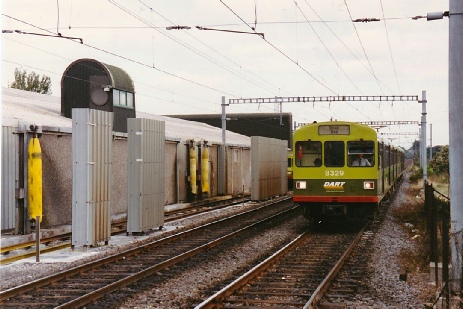
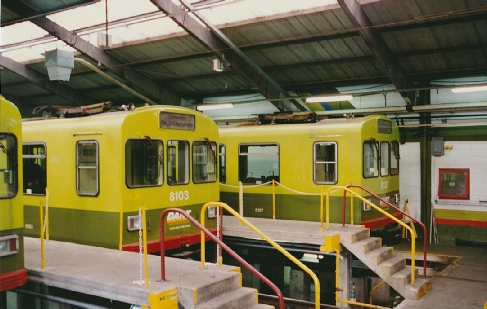
Linke-
8100 Class Dart units 8140/8340 and 8127/8327 inside Fairview Depot
Starting as we did underneath a unit we were informed about the life expectancy of brake pads, this being 8 months on a trailer and 14 months on a power car -
During the tour Louis also gave a detailed description of the cab equipment and radio with all its various uses. It was noted whilst going around the depot that it was fitted with a central vacuum cleaning system for train cleaning -
Louis finished the tour by explaining the driver's preparation duties; they are allowed 20 minutes which includes door testing. Fairview depot has 52 drivers on its staff and 16 drivers book on at Bray.
The tour of Fairview had been very interesting and was made more so by Louis' very informative and friendly approach. Return to Connolly was by D.A.R.T. train which Louis had stopped at the staff halt to collect our party. This gave us about an hour before lunch so an opportunity was taken by some members to look around Dublin.
After an excellent lunch we were introduced to Oliver Doyle the Product Manager Rail Passenger and Inspector Jack O'Hern; those of us on the visit to Ireland five years ago had met Jack on that occasion.
The party set off for Bray at about 14.30 and Jack O'Hern took members up front to see the A.T.P. in action: Practical demonstrations of its effectiveness being given whilst en route. It should be said that great faith was placed in the ability of this equipment to perform to specification without fail, which of course it did. Those of the party remaining in the train during the journey were given a good deal of detail about the D.A.R.T. by Oliver Doyle. We were also given a lot of historical detail about the line to Dun Laoghaire and beyond to Bray by Mr Doyle, who it transpired has written a history of the Irish Railways.
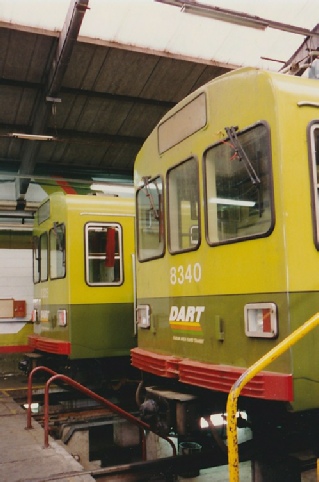
8100 Class Dart units 8140/8340 and 8125/8325 over the inspection pits inside Fairview Depot.
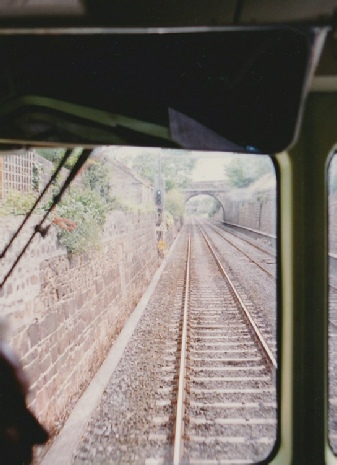
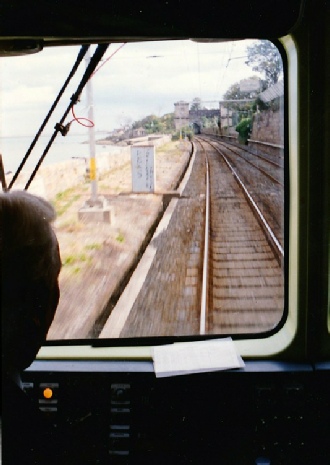
View from the cab of a 8100 DART unit 8329 between Dublin and Bray during which a demonstration of a ATP over-
On arrival at Bray, Mr Doyle pointed out some of the historical details of Bray station and its environs, following which we went to the drivers' room to have a look at the Bray diagrams and the impressive collection of plates on the wall, all taken within the Bray area.
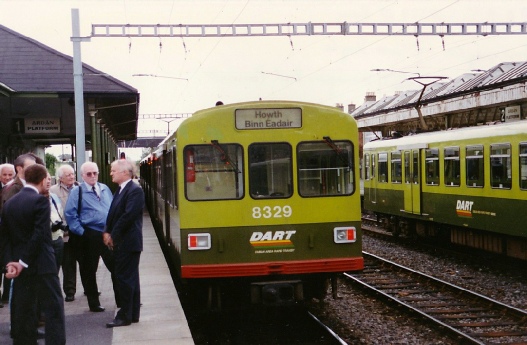
8100 DART 8129/8329 upon arrival at Bray. Oliver Doyle from Irish Rail is nearest the unit on the right.
The return to Dublin was made after about 30 minutes in Bray. During the return trip presentations were made to Oliver Doyle and Jack O'Hern and also to the driver of our return train. Mr Doyle however turned the tables on us when on our return to Connolly a box full of D.A.R.T. tee-
Despite the fact that it was now around 17.00 and Jack O'Hern was about to finish work, this did not stop him from inviting those members of the party remaining, over to Connolly loco, to have a look at the ex Dublin South Eastern Rly. 2-
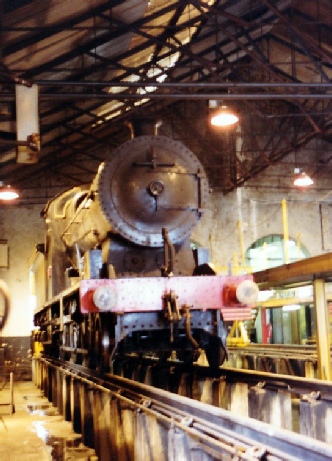
Dublin South Eastern Rly. 2-
A001 Class No. 003 at Dublin Conolly Loco Depot.
This locomotive has now been preserved by the Irish Traction Group
This rounded off what had been a very interesting day in a most pleasant fashion; a day which I would like to record was spent in the company of railwaymen of the highest order.
Wednesday 9th September:
Wednesday morning saw us catching the 08.00 to Belfast, this train being operated by I.R. -
We were met on arrival by Ken McKnight, the Suburban Passenger Manager for N.I.R. and an old friend of the Institution. We did not get very far from the train however as everyone off the Dublin train was lined up on the footbridge and searched for drugs and or explosives -
However with this short diversion out of the way, we adjourned for coffee and an explanation of the day's plans. Following coffee and the short chat, we caught the 11.05 to Adelaide, the train being provided with a special stop to drop our party off, our first stop being to the Adelaide goods yard which is located just outside Belfast.
On arrival at the yard office, Ken McKnight introduced us to Wesley Hill the yard manager who was to guide us around the facilities. It was explained that the yard was owned by Irish Rail and operated on their behalf by N.I.R. N.I.R. provide one pilot engine to shunt the yard, the other pilot loco is provided by IR and works in with a morning goods. The principle traffic handled by the yard include cement, fertiliser and containers. The containers being forwarded to the UK are transshipped at Adelaide and transferred by road to the docks, there being no rail connection at present though it is hoped that a connection can be restored in the future. The operating day for Adelaide yard is from 06.00 to 20.00, the yard being closed with the departure of the 20.00 freightliner for Dublin. It is howeve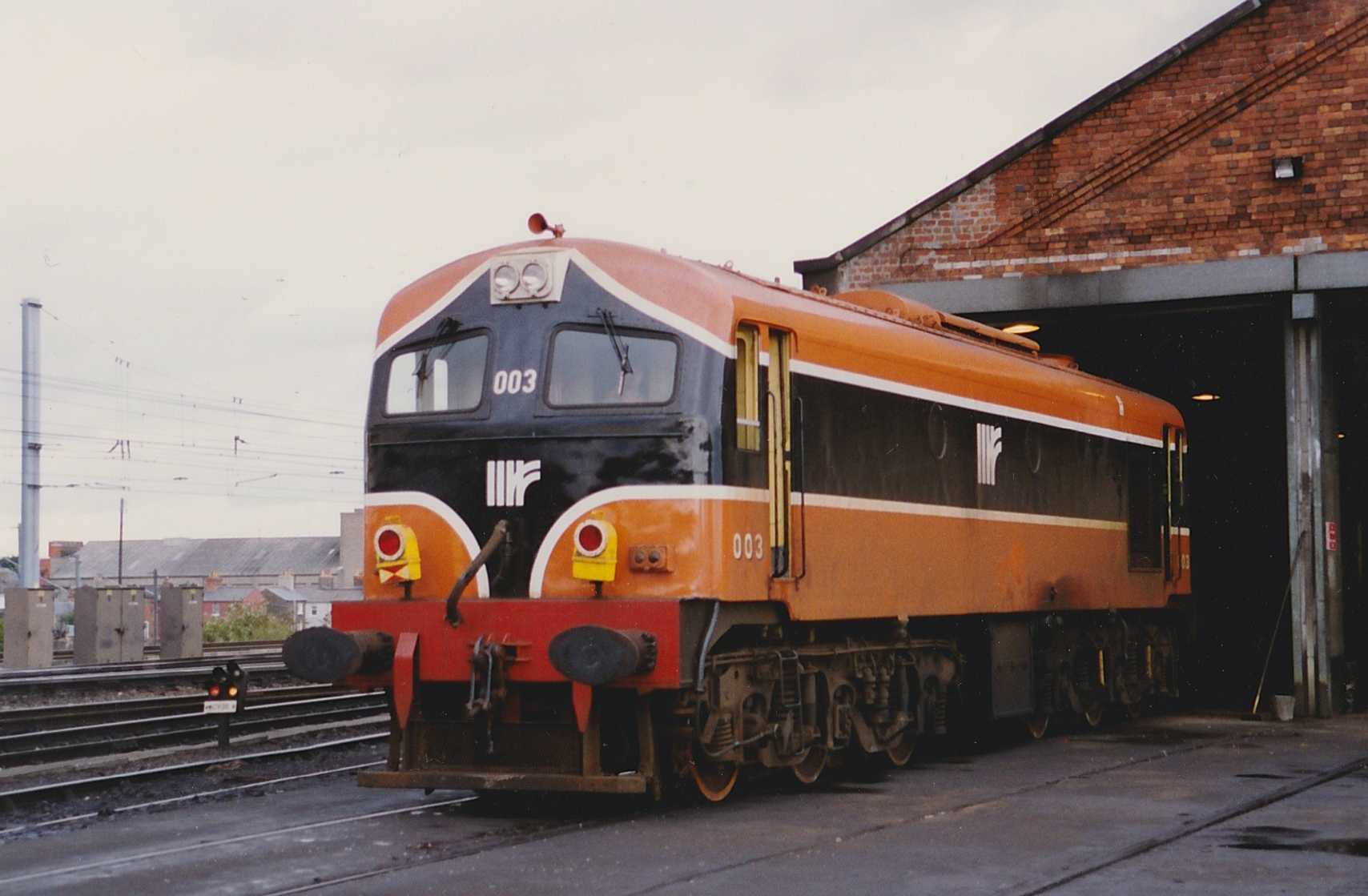 r anticipated that night operation will resume in the not too distant future.
r anticipated that night operation will resume in the not too distant future.
Finally, we were invited to climb to the top of the container crane for a grand view of the yard. Two members took up this offer.
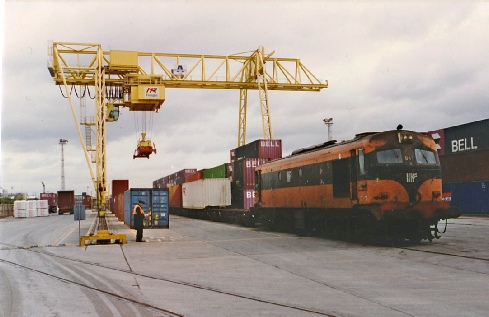
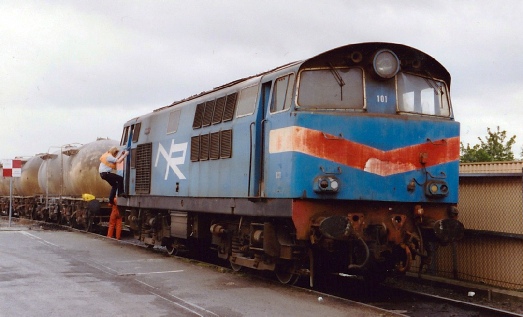
Irish Rail A001 Class No. 047 on a Freightliner to the Republic
Adelaide year pilot was NIR Hunslet 101 Class No. 101. Three of these locomotives were built in 1970 to work the Enterprise Services between Dublin and Belfast. The design of these locomotives was by Hunslet in Leeds and final assembly was at BREL Doncaster Works. They were fitted with a 1,350 hp English Electric CSVT engine.
By this time this locomotive was only fit for pilot duties.
101, originally called “Eagle”, was purchased by the Railway Preservation Society of Ireland and cannibalised for spares for classmate 102. It was finally scrapped in 2010.
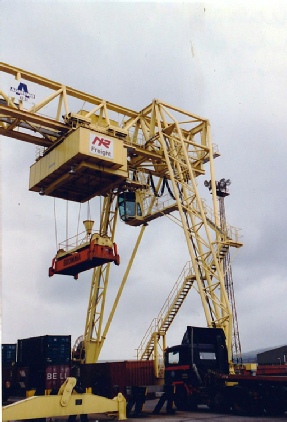
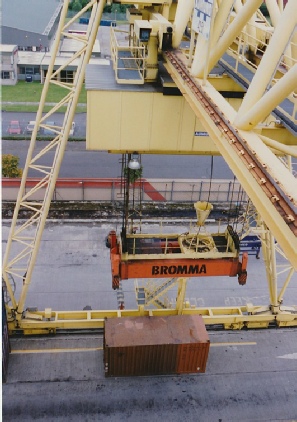
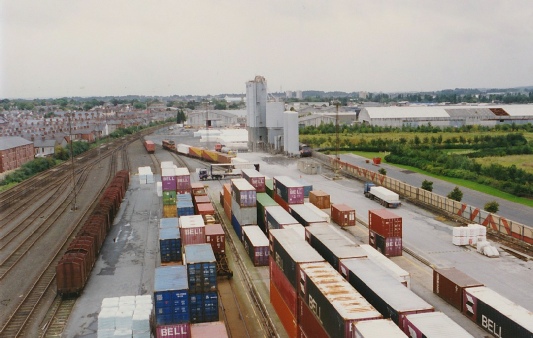
Views from the bottom and top of the Adelaide Yard container crane as well as a general view of Adelaide Yard taken from the top of the crane.
Before returning to Belfast, we thanked Wesley Hill for a very interesting morning and before departing we made a small presentation to Mr Hill. Return to Belfast Central station was made on the 12.37 and a break was made at this point for lunch, however before this the opportunity -
After an excellent lunch we travelled via the special inter-
After an excellent lunch we travelled via the special inter-
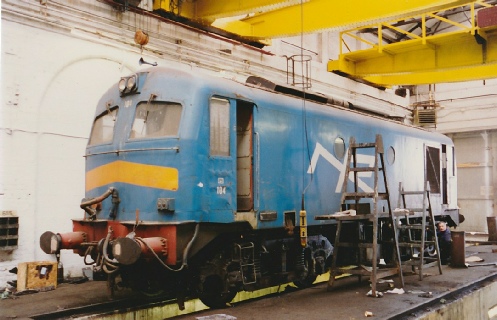
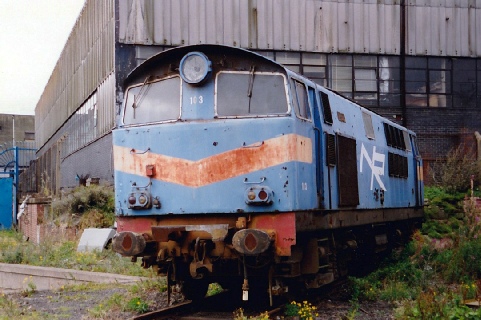
NIR 104 Class, No. 104 in Belfast York Road Works.
These Metro Vic locomotives were originally CIÉ (Irish Rail) C201 Class and were sold to Northern Ireland Railways in the mid 1980s. Like the A001, these had their Crossley engines replaced with GM EMD engines, in this case 8-
104 was originally CIR No. 216 and was scrapped in August 1997.
Withdrawn NIR 101 Class, No. 103 at the back of Belfast York Road Works.
This locomotive was scrapped in 1997.
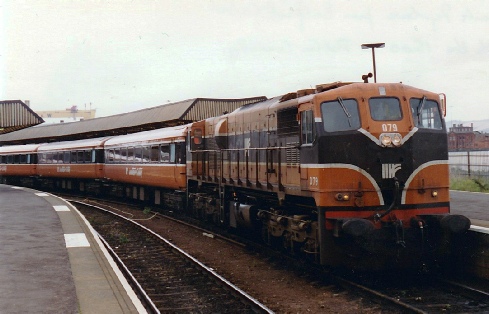
‘Large GM’ 071 Class No. 079 at Belfast Central on the 15.00 to Dublin Conolly.
The Large GMs were built in 1976 by General Motors Electro-
Currently (as of early 2015) all remain in service -
Despite the cramped site the works occupies, a wide range of tasks are undertaken by the workshop staff in the most competent fashion. These include all upholstery and timber work, motor repairs and major bogie overhaul, also some impressive restoration work on coaches which have suffered from arson attacks and level crossing accidents. Outside the works we noted one of the Hunslet/B.R.E.L. locomotives No. 103 awaiting scrapping along with other stock awaiting works attention. Also of special interest we noted construction of the new Cross Harbour link which will connect the Larne-
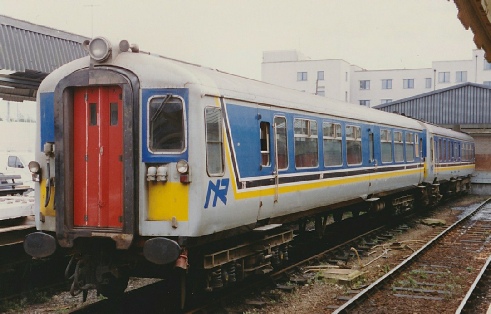
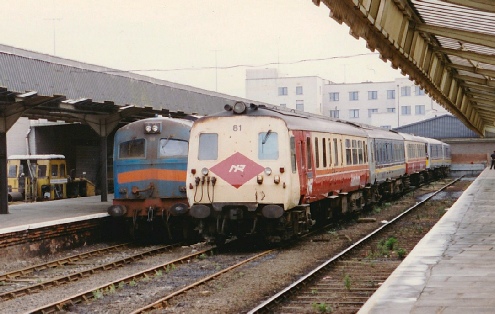
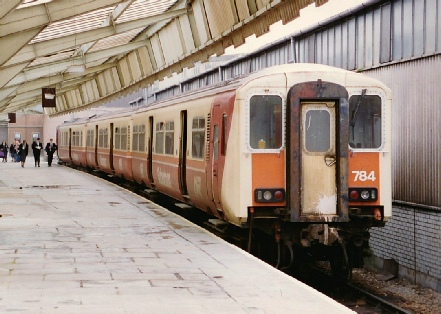
Two vehicles from NIR’s 80 Class DEMUS at York Road station.
These units where fitted with an English Electric 560 HP diesel engine.
All have now been taken out of passenger service, though a few coaches are retained for Sandite duties.
Driving trailer 732 nearest the camera was scrapped in 2006.
NIR 80 Class Power Car 81 as at the front of a mixed selection of 80 class vehicles. This vehicle was also scrapped in 2006.
On the left is NIR 104 Class Locomotive 108 which was stored in 1994 and scrapped in 1997.
NIR 450 Class or “Castle Class” DEMU, led by driver trailer 784 at York Road.
These units were built by British Rail Engineering Ltd between 1985 and 1987 and were fitted with a English Electric 4SRKT power unit recovered from the 70 Class.
All these units were taken out of passenger service between 2011 and 2012. One unit is preserved at the Downpatrick & County Down Railway
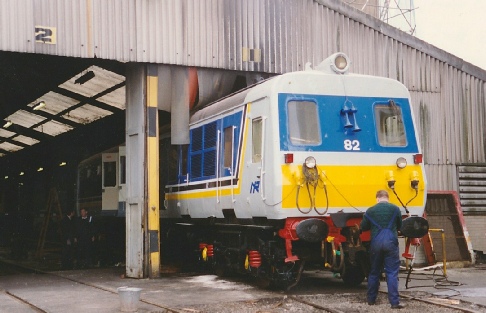
NIR 80 Class Power Car 82 freshly painted receives attention at York Road. Whilst used after withdraw from passenger duties on sandite duties, this power car was scrapped in 2012 due to cracked engine block.
A return was now made to Belfast Central on the bus in order to ride into the Central service depot on the E.C.S. off the 13.00 ex Dublin. I should say that the journey through the centre of Belfast gave little hint of the troubles, in fact you could have been in any city in the UK. The only hint of what was going on was when the bus entered what I assume was the principal shopping district. This was gated at each end and on entering the bus was searched in a most half-
Owing to the failure of two of N.I.R.'s class III diesels the 13.00 had been worked in by an Irish Rail loco on loan and it was anticipated that this same loco would work the train back -
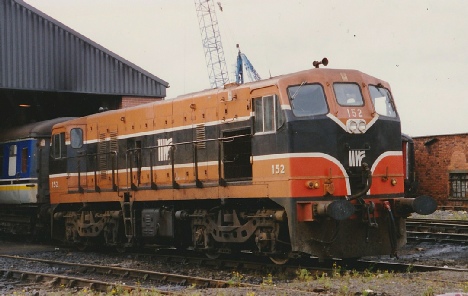
A tamper, two 80 Class DEMUs and Irish Rail Small GM 141 Class No. 152 at Belfast Central Servicing Depot
Irish Rail Small GM 141 Class No. 152 at Belfast Central Servicing Depot on a rake of NIR coaches. This locomotive is now preserved by the Irish Traction Group.
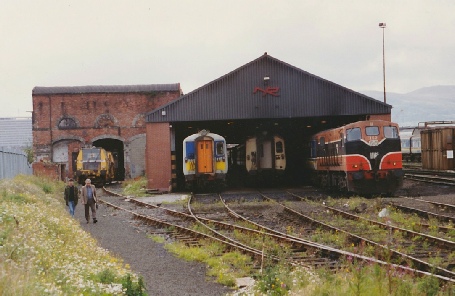
C.S.D. is a mixture of old and new buildings, the older building is used as a heavy repair shop for intermediate repairs on D.E.M.U.s and P. Way machines; a Castle Class D.E.M.U. was in for attention when we looked in. Next door is the 3 road running shed in which all day to day servicing and running repairs are made. Along with I.R. loco No. 152 and various D.E.M.U.s in the running shed was G.M. loco No. 112 which had just received repairs and it was this loco which replaced 152 on the 17.00.
After walking through the running shed we moved outside to the fuel point where we noted the Leyland R3 railbus which was out of service pending a decision on its future; it had previously been in service on the Portrush line.
After looking around the carriage sidings and some photo taking by the members, a group picture was taken in front of a newly repainted coach. Time was now sadly against us as the empty stock for the 17.00 was drawn out by 112, a surprise to us all, but a rather special surprise to two members who despite past visits to Ireland had never been able to track down and photograph this particular locomotive.
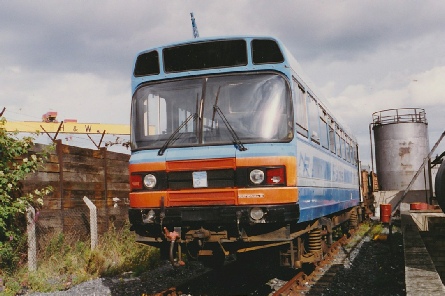
Looking every bit like a Leyland National bus on rail wheels the BREL R3 Railbus at the back of Belfast CSD. Note the Harland and Wolf shipyard crane in the background. R3 is now preserved on the Downpatrick and County Down Railway
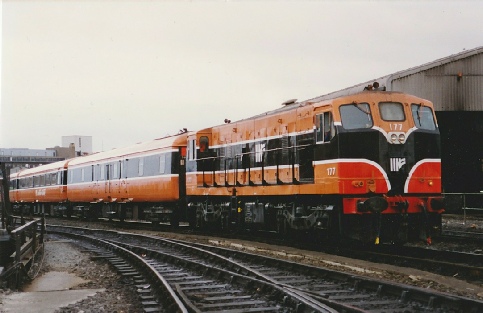
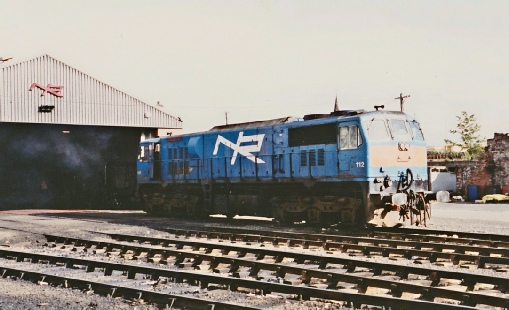
Irish Rail Small GM 141 Class No .152 at Belfast Central Servicing Depot with the Irish Rail coaches for the 17.00hrs Belfast Central to Dublin
NIR 111 Class No. 112 which powered the 17.00hrs from Belfast to Dublin. The 3 x Class 111s are almost identical to the Irish Rail Class 071, but are slightly newer with 111 & 112 built in 1980. All three remain in service.
After looking around the carriage sidings and some photo taking by the members, a group picture was taken in front of a newly repainted coach. Time was now sadly against us as the empty stock for the 17.00 was drawn out by 112, a surprise to us all, but a rather special surprise to two members who despite past visits to Ireland had never been able to track down and photograph this particular locomotive.
On arrival in Belfast Central station we thanked Ken McKnight for what had been a very interesting day and one in which Ken had been with the party throughout the day. A number of members took the opportunity to ride on the locomotive whilst en route back to Dublin.
Thursday 10th September:
Thursday was a free day and after a late breakfast Ray Wadey and myself headed for Connolly station to take some photos before going to Heuston station to catch the 11.35 to Waterford. We watched 076 back on to our train and after a quick word with the driver and showing him the footplate pass we took up positions on the engine.
Our driver was a Waterford man who had worked up to Dublin that morning and was now returning with the 11.35. Despite the fact that our driver had only one year to go before retirement he had a very active interest in all things that currently affected footplate staff, our conversation went into rates of pay, rest day working, driver only operation and so on.
As well as all this, the journey itself was not without interest. The first part of the journey to Kildare is on the double track and C.T.C. controlled Cork main line, but from Cherryville Jct. where the Waterford line is taken we turn onto a single line which is controlled by electric token -
We only had 1 hr 15 minutes in Waterford, so it was a few photos and something to eat before returning on the cushions with Peter Martin who had made the journey to buy a piece of Waterford Crystal. The return journey was delayed because of a block failure between Kilkerry and Muine Bheag, -
Meeting later that evening with other members, it appears that many various places had been visited including Wexford, Malahide, Galway and Ballina, and it transpired that news about the B.R. men had reached the Galway line before today's visits. It would appear that a good time had been had by all and most people had avoided the rain.
Friday 11th September:
Friday morning started with a near disaster in the pouring rain. With a number of bus stops to choose from, I chose the wrong one, however we moved just in time to flag down a bus to Heuston station thus enabling us to catch the 07.30 to Cork which turned out to be an enjoyable journey accompanied after a short time by the sun which shone brightly for the rest of the day.
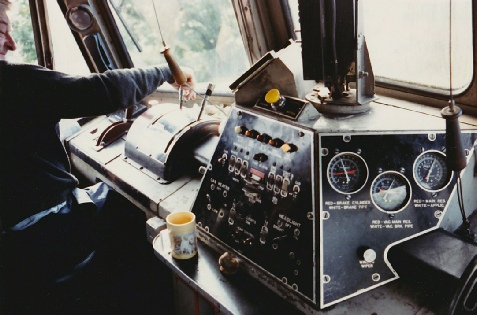
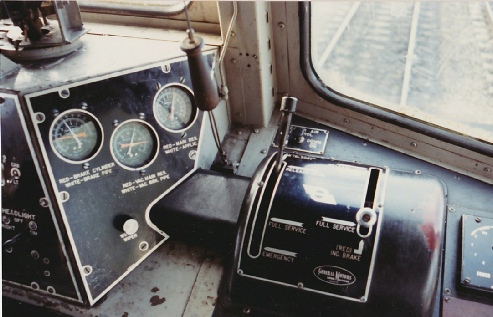
In the cab of the 071 Class No. 071 on the way to Cork. Note the wooden whistle handles hanging down on string.
Close-
On returning to Cork, lunch was taken in the station buffet, an area having been screened off for our party. After lunch several hours were now available to see the sights in Cork and this proved to be an effective way to wind down after the week's hectic programme.
Our return to Dublin was on the 17.30 and this was worked by a Cork driver on a lodging turn; he returns on the Saturday morning with the 07.30. This was the final opportunity for some cab riding on Irish Rail and a number of us took the opportunity.
On arrival back at our hotel, everyone had a quick wash and brush up before we set out for Hughes' pub just the other side of the Liffey in order to revive the former Institution practice of all the party on a continental visit sitting down together for a final drink and chat about the week. Yours truly must have gone a bit soft as I bought a round of drinks for the party and thus ended the 1992 visit to Ireland.
Saturday 12th September:
Breakfast at 06.15 was followed by a fleet of taxis to take us to Connolly station for the 07.00 D.A.R.T. Departure for Dun Laoghaire. Our ship departed on time and the crossing was smooth and uneventful with a right time arrival in Holyhead. We now had to wait an hour and twenty minutes for our train to Euston. This was the drawback to using one H.S.T. set to cover Irish services. The H.S.T. set arrives on the morning train is unloaded, cleaned and labelled in around 30 minutes, then shunted over for its departure at 13.52. Arrival in Euston was a few minutes late but only because of the very generous 30 minute allowance from Watford to Euston.
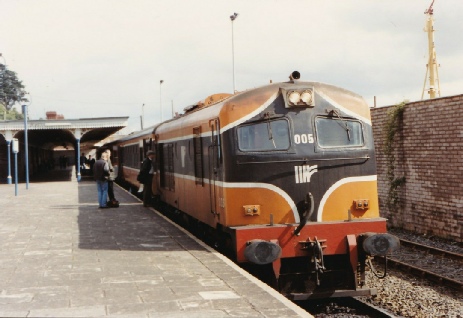

The cab of A Class 005.
The cab was noticeably quitter and smother than the 071/111 cabs ridden on earlier in the trip, the dominate noise being the clock-
A Class 005 prepares to leave Cobh on the 13.45 to Cork
We were met in Cork by Sean Culinane, the station master at Cork station and he took us first to the buffet for morning coffee, after which a number of us took a brief visit around the yard and loco shed accompanied by Mr Cullinane.
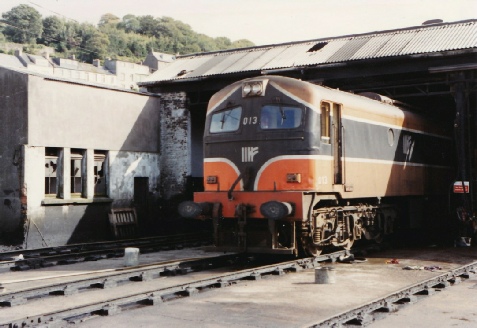
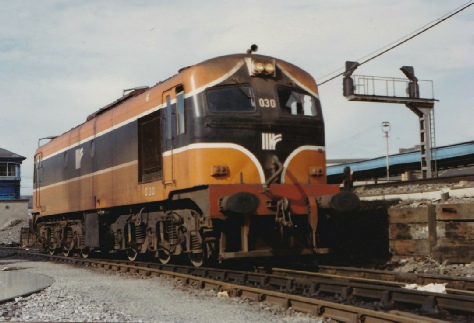
A001 Class No. 013 pokes its nose out of Cork shed.
A001 Class No. 030 at Cork loco yard.
After the short visit the entire party caught the 11.20 to Cobh , this train being headed by Metro Vic A Class No. 005. I and Ray Wadey decided to take the opportunity to ride on this veteran locomotive to Cobh. The A Class had been introduced in 1955 and were originally built with Crossley engines of 1200 hp, these being replaced from 1968 onwards by General Motors engines of 1325 hp. This particular locomotive was confined to the Cork Cobh service because it had a traction motor linked out. It was noted that this locomotive rode far better than the G.M. locomotives despite the indifferent track.
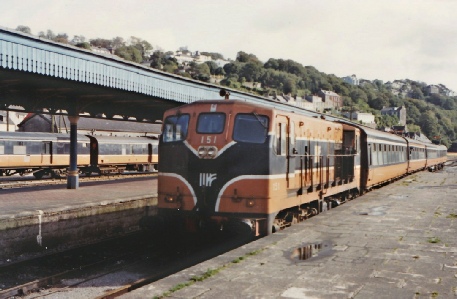
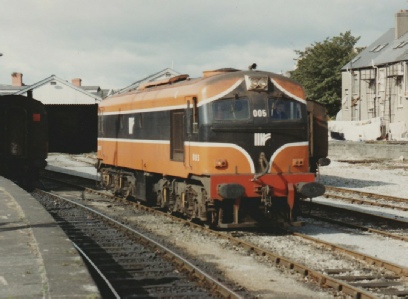
GM 141 No 151 arrives at Cork with the 10.45 from Cobh.
A001 Class No. 005 then moves to the front of the 11.20 Cork to Cobh.
|
Related Pages: |
|
|
|
Ireland in 2016, including a visit to Inshicore Works, Dublin Area CTC, Drogheda Commuter Depot and Castlerea Museum |
|
Our return trip to Ireland in 2015 - |
|
